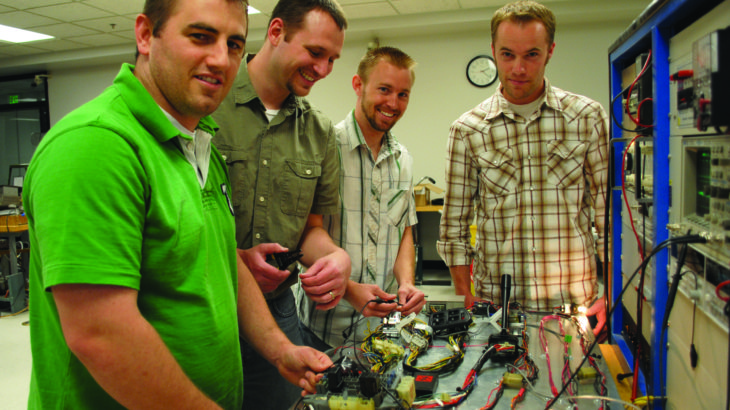University of Utah student Jordan Nicholls earned a master’s degree in engineering in May 2010 — but he was absent on graduation day.
Rather than don the ceremonial cap and gown, Nicholls participated in a national business plan competition with three of his fellow engineering students. Their success at the Moot Corp business plan competition capped an unparalleled school year in which they earned a total of $86,500 to help develop and market their new technology.
The team’s success demonstrates how student groups can hone their skills and earn valuable seed money by participating in the many student programs available through The Pierre Lassonde Entrepreneur Center and the Sorenson Innovation Center at the University of Utah.
“The Short Solutions team did an incredible job ramping up a very steep learning curve to get their business plan together,” says Troy D’Ambrosio, the Director of The Lassonde Center. He has served as one of the team’s advisors as they have worked to commercialize their invention.
The group consists of Nicholls, Chase Thompson, Justin Ferguson and Chad Mann. Together, they call themselves Short Solutions. In the 2008-2009 school year, they sought to find a solution to intermittent faults in automobiles, and they successfully identified a method that they are currently trying to bring to the marketplace. Intermittent faults are those that are inconsistent and difficult to detect. Short Solution’s method for identifying these faults uses spread spectrum time domain reflectometry (SSTDR), which works by continuously sending a test signal down a wire and comparing the readings to a baseline measurement.
Dr. Cynthia Furse, Associate Vice President for Research at the University of Utah and a pioneer of SSTDR, inspired the idea for their initial research project.
But developing the technology was only half of the challenge. Once they had their product, they had to find a way to start turning it into a viable product. That’s where The Pierre Lassonde Entrepreneur Center enters the picture.
Through the Lassonde Center, they were turned on to a series of student competitions that build on each other. At the least, students in the competitions gain insight into the business process that they can apply to their inventions and careers. And, at the best, they earn substantial sums of money to develop and market their product. Short Solutions was one of the more successful student teams during the 2009-2010 school year.
The team’s first competition was Opportunity Quest, where student entrepreneurs compete for $10,000 in startup cash by completing a business plan executive summary. Short Solutions didn’t win anything at that event. But they were one of the top-10 finalists, and they learned some valuable lessons that they applied in the Utah Entrepreneur Challenge (UEC), where a full business plan was required.
At UEC, Short Solutions swept the field to win the competition and claim the $40,000 purse. They also won the right to compete in the Global Moot Corp Competition in Austin, Texas. Only 40 teams from across the world earned the chance to compete at Moot Corp.
While Short Solutions did not make it to the finals at Moot Corp, they won the Palo Alto Software Challenge in one of five challenge rounds, which earned them $1,000 in addition to the $500 they earned for participating in the event.
“Not being business students, we had to play a little bit of catch-up, but our engineering background gave us the foundation that we needed,” Nicholls said.
Yet, for all of their successes, the road for Short Solutions has only just begun. While they have secured a substantial amount of money, it is only a fraction of the funding they will need to fully develop their product and bring it to the marketplace. They are hoping to secure private venture funding to fill the gap.
In the meantime, they will be relishing their rapid success at the student competitions.
Learn more at www.shortsolutionsengineering.com.



